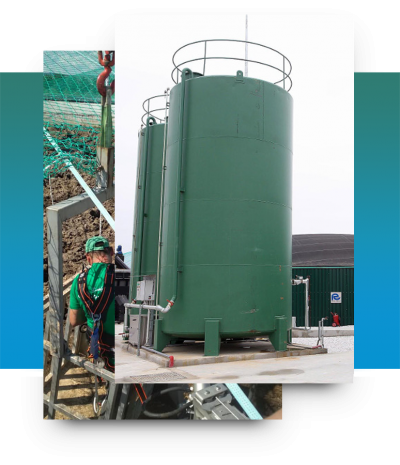Scope of the project
THE ROLE OF ANAEROBIC DIGESTION
Anaerobic digestion of organic substrates (livestock waste, agricultural residues, etc.) is carried out by the combined action of various microorganisms in an environment that lacks oxygen. This process involves a series of complex reactions. The result is the conversion of organic matter into biogas (CH4 and CO2) and stabilized organic matter. Biogas technology is considered the most sustainable route for the treatment of agro-industrial waste as in addition to reducing the environmental impact of various agro-industrial and agricultural activities resulting from its use, energy is also recovered in the form of CH4. The generated CH4 is used in cogeneration systems (CHP). Τhe generated renewable electricity is sold to the electricity grid operator making the technology an attractive investment.
BIOGAS UNITS IN GREECE
In recent years, significant investments have been made in the field of biogas in Greece, while in 2012 there were less than 10 biogas units with a total electricity capacity not exceeding 4-5MWe, today there are 28 operating units1 with a total capacity exceeding 25 MWe. In the area of Thessaloniki are currently three biogas plants, one is the partner BIOGAS LAGADA SA operating in Lagadas, one in Pentalofo Thessaloniki and one in Chalkidona. Each biogas unit has 1 MWe capacity. It should be noted that all three units started their operation in 2016.
Ammonia-rich substrates, such as animal waste (livestock waste) and slaughterhouse waste are raw material of biogas plants which cannot be excluded. Unfortunately, plants that use animal waste to produce biogas, or other nitrogen-rich substrates, operate in conditions of “unstable operation” with losses in the production of methane up to 30%, due to the toxic action of NH3. Most of biogas plants in Greece operate under these conditions.
The tendency to install new biogas plants is expected to increase and therefore all available organic waste-substrates are necessary to ensure their normal function.
ANALYSIS IN SAMPLES OF BIOGAS LAGADA S.A.
It should be mentioned that: QLAB (project coordinator and certified analysis center in biogas plants) proceeded with analysis of volatile fatty acids (VFA) in effluent samples of BIOGAS LAGADA SA. in February 2017 and found that they contained acetic acid at a concentration of 2000 mg/L, in addition to the other fatty acids found in the samples. The concentration of acetic acid is an indicator of completion of anaerobic digestion. Low to zero values characterize the completion of the process, while high values indicate instability in the operation of the biogas plant and pause of further biochemical conversion of acetic acid to CH4.
CH4 is produced by two metabolic pathways during the methanogenic stage: a) acetoclastic methanogenesis, where acetic acid is converted to CH4 and CO2, and b) hydrogenotrophic methanogenesis, where CH4 is produced by hydrogenotrophic microorganisms that consume H2 and CO2.
The high hydraulic retention time (HRT 43 days) that BIOGAS LAGADA applies in combination with the incomplete decomposition of the organic matter resulting from the increased concentrations of acetic acid, led BIOGAS LAGADA to further investigate the issue. The loss in CH4 in the case of BIOGAS LAGADA amounted to approximately 32% of the total production capacity of CH4. From 2000mg / L or ~ 33mmoles of residual CH3COOH are produced 33mmoles CH4 corresponding to ~ 750mL CH4 /L substrate.

The concentration of ammonia nitrogen (NH4-N) in the samples was equal to 2.3 g/L of substrate and in combination with the toxicity test performed by the AUTh partner, it was concluded that the increased concentrations of CH3COOH are mainly due to NH3 toxicity. It should be noted that NH3 mainly inhibits the action of aceticoclastic methanogenic archaea contributing to increased concentrations of CH3COOH.
Another important fact is the seasonality of organic substrates in Greece which causes fluctuations and often sharp increases in NH3 concentrations in the bioreactor resulting in the disruption of anaerobic digestion.
FREE NH3 IN BIOGAS PLANTS
NH3 is a metabolic product of the anaerobic digestion of nitrogen-containing organic substances. During anaerobic digestion, nitrogen-rich organic compounds (proteins, urea) are broken down into fatty acids and NH3. Nitrogen is essential for the growth of biomass of microorganisms, but as it is found in excess in animal waste, it is not consumed but is present in the aqueous solution in the form of ammonia ion or free NH3. The form of free ammonia is toxic to methanogenic populations. Free NH3 even in small amounts of 150mg/L reduces methane production. It is common for free NH3 concentrations in biogas plants to exceed 1100mg/L when using livestock waste or slaughterhouse waste.
Free NH3 is in chemical equilibrium with the ammonia ion, when increasing pH and temperature, the concentration of free NH3 increases. In a research of AUTh, it was shown that the addition of zeolite to livestock waste, resulted in a 52% increase in methane production. Zeolite binds with the ammonia ion resulting a reduction of the concentration of free ammonia However, the addition of binding materials to ammonia nitrogen is far from any commercial application. Three problem-solving methods are commercially available: a) the fusion with nitrogen-poor substrates, b) the operation of the unit with low solids concentration and c) the NH3 stripping method from the waste before it is introduced into the bioreactor.
However, the first cannot be applied in Greece, where the feed supply of the units is not constant and where all the seasonally available organic matter is used, within a geographical area that is economically advantageous to transport the substrates. The second and third are economically unprofitable, as the operation of the unit with low solids concentration has low efficiency with high initial installation costs. Furthermore, the existing NH3 stripping method requires large amounts of energy and alkaline pH adjustment to heat the substrates in the temperature where all NH4-N will be converted to free NH3 to escape into the atmosphere after aeration.


